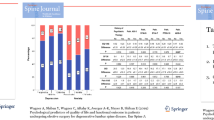Abstract
The authors aim to evaluate the ability of spine surgeons to subjectively identify patients with psychological distress in a subset of lumbar fusion candidates, and the influence of such factors on surgical outcomes. From a cohort of 85 patients who had received a surgical indication for lumbar fusion and were subjectively evaluated for psychological distress, 60 were included in the study and underwent objective evaluation using the Distress Risk Assessment Method (DRAM) evaluation for depressive/distress symptoms, VAS and Oswestry scores pre- and postoperatively. Fifty-six patients were available with a minimum 6-month follow-up: 20 presented with normal DRAM scores, and 36 with abnormal DRAM (28 at risk; 4 distressed somatic; 4 distressed depressive). Although the group improved significantly with surgery regarding VAS and Oswestry, it was not the case for the DRAM score. The abnormal DRAM group had inferior VAS, Oswestry and satisfaction rates in comparison with the normal DRAM group. A significant number of patients in the at-risk group reduced their DRAM scores and were classified as normal patients at the end of the study. This study emphasizes the need for objective psychological screening on chronic low back pain patients and that although patients with abnormal DRAM scores benefit from surgery, they report inferior outcomes and satisfaction in comparison with the normal DRAM group.
Similar content being viewed by others
References
World Health Organization (2015) WHO chronic rheumatic conditions. http://www.who.int/chp/topics/rheumatic/en/index.html. Accessed 7 March 2015
Andersson GBJ (1999) Epidemiological features of chronic low-back pain. Lancet 354:581–585
Gatchel RJ, Peng YB, Peters ML, Fuchs PN, Turk DC (2007) The biopsychosocial approach to chronic pain: scientific advances and future directions. Psychol Bull 133:581–624
Chaichana KL, Mukherjee D, Adogwa O, Cheng JS, McGirt MJ (2011) Correlation of preoperative depression and somatic perception scales with postoperative disability and quality of life after lumbar discectomy. J Neurosurg Spine 14:261–267
Mannion AF, Elfering A, Staerkle R, Junge A, Grob D, Dvorak J et al (2007) Predictors of multidimensional outcome after spinal surgery. Eur Spine J 16:777–786
Zoëga B, Kärrholm J, Lind B (2000) Outcome scores in degenerative cervical disc surgery. Eur Spine J 9:137–143
Katon W, Ciechanowski P (2002) Impact of major depression on chronic medical illness. J Psychosom Res 53:859–863
Amaral V, Marchi L, Oliveira L (2010) Prevalence and relationship of emotional and clinical factors in patients with degenerative disc disease. Coluna/Columna 9:150–156
Falavigna A, Righesso O, Teles AR, Baseggio N, Velho MC, Ruschel LG et al (2012) Depression subscale of the hospital anxiety and depression scale applied preoperatively in spinal surgery. Arq Neuropsiquiatr 70:352–356
Antunes RS, de Macedo BG, Amaral TDS, Gomes HDA, Pereira LSM, Rocha FL (2013) Pain, kinesophobia and quality of life in chronic low back pain and depression. Acta Ortop Bras 21:30–32
Sinikallio S, Aalto T, Koivumaa-Honkanen H, Airaksinen O, Herno A, Kröger H et al (2009) Life dissatisfaction is associated with a poorer surgery outcome and depression among lumbar spinal stenosis patients: a 2-year prospective study. Eur Spine J 18:1187–1193
Sinikallio S, Aalto T, Airaksinen O, Herno A, Kröger H, Savolainen S et al (2007) Depression is associated with poorer outcome of lumbar spinal stenosis surgery. Eur Spine J 16:905–912
Wahlman M, Häkkinen A, Dekker J, Marttinen I, Vihtonen K, Neva MH (2014) The prevalence of depressive symptoms before and after surgery and its association with disability in patients undergoing lumbar spinal fusion. Eur Spine J 23:129–134
Daubs MD, Patel AA, Willick SE, Kendall RW, Hansen P, Petron DJ et al (2010) Clinical impression versus standardized questionnaire: the spinal surgeon’s ability to assess psychological distress. J Bone Joint Surg Am 92:2878–2883
Block AR, Ohnmeiss DD, Guyer RD, Rashbaum RF, Hochschuler SH (2001) The use of presurgical psychological screening to predict the outcome of spine surgery. Spine J 1:274–282
Main C, Wood P, Hollis S, Spanswick C, Waddell G (1992) The distress and risk assessment method a simple patient classification to identify distress and evaluate the risk of poor outcome. Spine (Phila Pa 1976) 17:42–52
Fairbank JC, Couper J, Davies JB, O’Brien JP (2000) The Oswestry low back pain disability questionnaire. Spine (Phila Pa 1976) 25:2940–2952
Ribeiro WS, de Jesus Mari J, Quintana MI et al (2013) The impact of epidemic violence on the prevalence of psychiatric disorders in Sao Paulo and Rio de Janeiro, Brazil. PLoS One 8(5):e63545
Grevitt M, Pande K, O’Dowd J, Webb J (1998) Do first impressions count? A comparison of subjective and psychologic assessment of spinal patients. Eur Spine J 7(3):218–223
Miller J, Derakhshan A, Lubelski D, Alvin M, McGirt M, Benzel E et al (2015) The impact of preoperative depression on quality of life outcomes after lumbar surgery. Spine J 15:58–64
Conflict of interest
None.
Author information
Authors and Affiliations
Corresponding author
Electronic supplementary material
Below is the link to the electronic supplementary material.
Rights and permissions
About this article
Cite this article
Vialle, E., de Oliveira Pinto, B.M., Vialle, L.R. et al. Evaluation of psychosomatic distress and its influence in the outcomes of lumbar fusion procedures for degenerative disorders of the spine. Eur J Orthop Surg Traumatol 25 (Suppl 1), 25–28 (2015). https://doi.org/10.1007/s00590-015-1641-2
Received:
Accepted:
Published:
Issue Date:
DOI: https://doi.org/10.1007/s00590-015-1641-2




